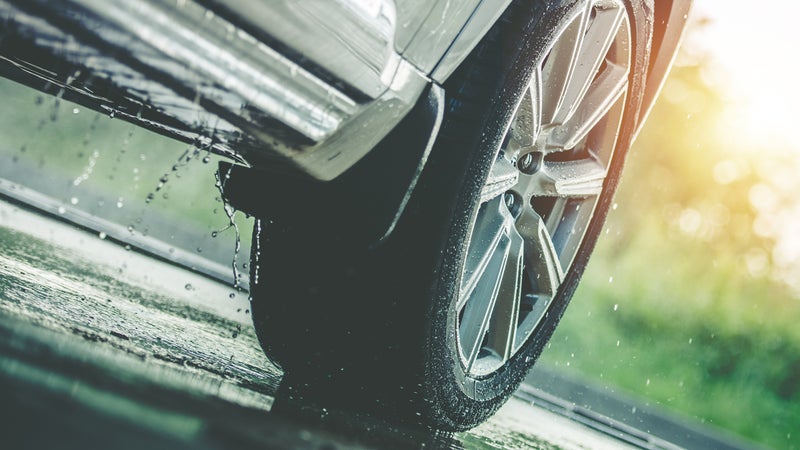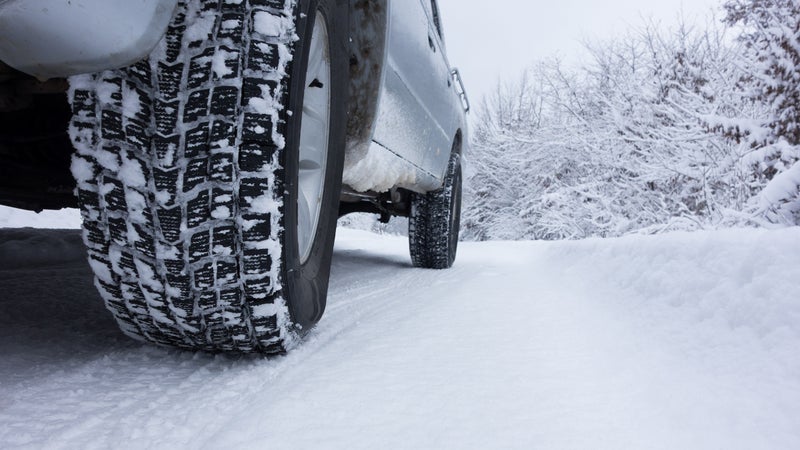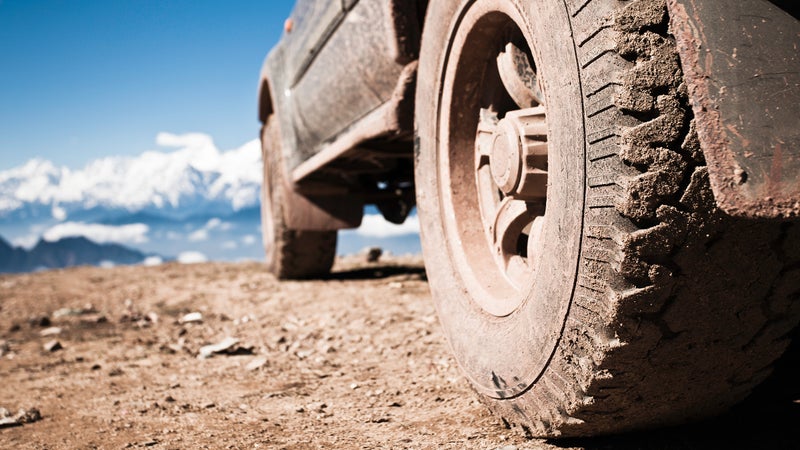Can You Put Off Road Tires on a Car
For exclusive access to all of our fitness, gear, adventure, and travel stories, plus discounts on trips, events, and gear, sign up for Outside+ today.
Whether you're taking a cross-country road trip, overlanding in your four-wheel-drive rig, or heading up to the ski area, having the right tires on your vehicle will get you there safer and more comfortably. Many drivers don't give their tires a second thought, but those black round things are the only connection your machine has with terra firma. Choose wisely, and you'll vastly improve your ability to get where you want to go. Pick the wrong ones, and you could end up in a fender bender, stuck in the wilderness, or worse.
Things to Know
Basic Tire Construction
Quite a bit of science goes into these rubber doughnuts. Obviously, the base material is rubber, which is actually a shade of white when it's pure. Tires become black after the addition of carbon black powder (commonly known as soot), which can be incorporated in different formulas to the rubber of your tires, primarily for strength and abrasion resistance. Carbon black and silica can be added to the compound to optimize grip, tread wear, fuel mileage, and strength.
Underneath the rubber, perpendicular belts of steel and nylon fabric are woven into blankets to help provide the tire with its structure and strength.
Tires are primarily spoken about in terms of four components: a bead, a sidewall, a shoulder, and a tread.
The bead is the part of the tire that connects it in an airtight seal to the metal wheel rim. This segment of the tire is constructed as a series of high-tensile steel wires wrapped in a hardened rubber, with ribs to prevent the tire from rotating on the rim.
The sidewall connects the contact patch of the tire to the rim, and its height helps determine the handling and ride of your car. A taller sidewall will generally help create a cushion between the road and your wheels, damping some abrupt impacts, like potholes and ruts. A shorter sidewall is usually desirable for grip on pavement.
The shoulder is the transition between the sidewall and the tire tread. Most on-road tires have a sharper shoulder angle, which reduces road noise and increases fuel economy. Off-road tires will often extend the tread pattern across the shoulder, allowing for more grip in loose terrain. This translates to more noise on pavement and less predictable grip when cornering, but the dirt-driving benefits are often worth the trade-off.
The most important part of the tire is the tread. This is the actual contact patch between your car and the ground. It is made up of tread blocks (the raised sections) and voids (the space between the blocks). In general, a shorter tread block and less void between each creates the maximum contact patch on paved roads, while a taller tread with larger gaps between blocks will be conducive to grip on dirt trails, since the tires can bite into and conform around the terrain more.
Sizing
Tire sizes can be a little confusing. The first number is the width of the tread in millimeters. The second number is the height of the sidewall, represented as a percentage of the tread width. The third number is the wheel diameter that the tire fits on. So for example, a 225/50-15 tire would have a 225-millimeter-wide tread, a sidewall that's 112.5 millimeters high, and it would fit on a 15-inch rim.
Ratings
If you have a pickup that you use for hauling serious loads or pulling trailers, you should have light-truck-rated tires instead of the standard P-metric tires designed for most passenger vehicles. Light trucks are considered to be any available for regular use, as opposed to commercial transportation or industrial purposes. The tires are generally standard-issue on three-quarter and one-ton pickups, but they're also stiffer than normal tires, which can mean a harsher ride. Make sure that you're balancing how much you plan on hauling, and how often, with the kinds of surfaces you'll be driving on.
Tire Types

Highway Passenger
General-use tires for everyday driving are typically called passenger tires, and within that classification, there are dozens of different types for daily use. Some are good for light off-roading, and some are burly for longer lifespans. Others are built for luxury and comfort or specifically to improve your fuel mileage with low-rolling resistance. And then there are the tires that straddle multiple different disciplines, like all-season tires. For the purposes of this guide, we'll gloss over most of those categories and instead focus on the three other main types of tires. Just know that if a tire is designed for more than one purpose, it's inherently a compromise and may not be the best for a specific task.

Winter
We'll start with a type of tire often overlooked by American drivers: the winter tire. All of Germany and parts of Canada mandate their use during inclement weather seasons. I asked Tire Rack's product-information specialist Woody Rogers to explain when you should consider winter tires. "In the simplest terms, winter tires are suitable for any driver whose winter season consists of average temperatures below 40 degrees and who experiences anything more than infrequent snow, slush, or ice conditions," he says.
Winter tires are formulated with generally more silica, to give your vehicle maximum traction on ice and snow. Most people only associate traction with being able to accelerate without spinning their wheels, but it's incredibly important for cornering and braking as well. As a general rule, don't think every good winter tire is wide; you want a narrower one on snow-covered or icy roads so the car's weight can sink them into the snow instead of skating over the top of it.
Rather than just having a set of winter tires, it's helpful to mount them on a second set of dedicated wheels, so you can change them out yourself at the first sign of cold weather instead of needing a shop to swap tires onto your wheels. Generally, it's a good idea to get a set of wheels downsized an inch from stock, allowing for a taller and softer sidewall than your everyday tires but in a total package that's the same size. A softer sidewall will deal with ice chunks and potholes better.
Even if you live somewhere temperate that doesn't require winter tires, if you take frequent drives to ski resorts, I recommend getting a set. The safety and peace of mind provided by winter tires is invaluable. And they could save you thousands of dollars when you stop just short of rear-ending the car in front of you, whereas your all-seasons might leave your front bumper in their back seat. Owning a second set of winter tires for your car is rarely inexpensive, especially for modern cars and trucks, but for an average set of 18-inch wheels and tires, budget at least $1,000.
I'm a fan of Bridgestone's Blizzak, invented in the early 1990s as the first modern studless winter tire. The line remains one of the best options for any driver.

Off-Road Truck and SUV
If your plan is to head out into the wilderness, be it for light overlanding, the occasional fire road, or heady rock-crawling trails, you'll need something better suited to the task than a run-of-the-mill highway tire.
The tread pattern of an off-road-capable tire is much more aggressive, typified by a larger void between tread blocks. The width of the void area allows the tread blocks to sink down into loose surfaces like dirt, rocks, light sand, and mud to gain traction. This tread pattern is also much deeper than a typical tire's, allowing the voids to be filled by the low-grip terrain, effectively treating the treads as individual paddles scrabbling for traction.
You want strength in a tire that you plan to take into deep forest trails or across miles of desolate desert, and for that reason these tires are built to be resistant to cuts, chips, and tearing. (A standard highway tire would be torn up relatively easily after a short time off-road.) The sidewalls of off-road tires are thicker, reinforced with extra steel, fabric, and high-density rubber to help prevent cuts and punctures.
That stronger sidewall also helps prevent the tire from coming loose from the bead of the wheel. Tires are designed so that, when inflated, the internal pressure pushes the bead of the tire against the inside of the wheel rim. You should air down the tires each and every time you go off-road to give them larger footprints on particularly sandy or slick dirt and rock. Twenty psi is a good pressure to start with. (Consult your owner's manual for safe on-road pressures, and inflate to those before you return to pavement.) Be careful not to remove too much air, though, as the tire can de-bead and deflate. When you're forty miles down an unbeaten path, that's a real problem. The stronger sidewall makes it less likely that the the tire will deform in a way that would separate it from the rim.
There are varying levels of off-road tire performance, including dedicated models that will be too stiff and loud for street use. Take mud-terrain tires, which have the most capability (save on sand). But the large, chunky tread creates vibrations when slammed into hard pavement. That hard rubber is great for longevity in the dirt, but it's a hellacious noise when pressed into daily driving duty. An all-terrain tire will perform much better on asphalt and is all most people need for the level of off-roading they're doing.
It's always best to talk to an experienced off-roader before you commit to purchasing a tire for your specific needs. If you want a daily-driver tire that is also capable of dirt-trail driving, check out BF Goodrich's All-Terrain T/A KO2. These can be mounted on a standard wheel, and an 18-inch will cost around $900 for just the tires.
The Upshot
While many people never even think about their tires, they are the single most important factor when it comes to your vehicle's performance. There are also plenty of places, like Tire Rack, where you can read consumer reviews of a specific tire before you buy. Having the proper tire for your needs can mean making it up a hill and getting to your destination and back. Get the right rubber.
Can You Put Off Road Tires on a Car
Source: https://www.outsideonline.com/outdoor-gear/cars-trucks/comprehensive-adventure-vehicle-tire-guide/
0 Response to "Can You Put Off Road Tires on a Car"
Post a Comment